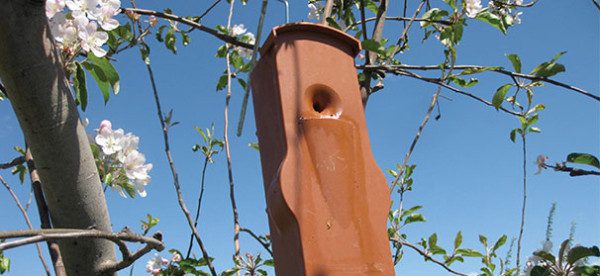

Jan 30, 2014WSU research studies aerosol pheromone emitters
Research in Washington state has shown that aerosol pheromone emitters can suppress codling moth as well as hand-applied dispensers, according to Jay Brunner, an entomologist with Washington State University (WSU).
Brunner discussed WSU pheromone research at two industry shows in December: the 109th annual meeting of the Washington State Horticultural Association in Wenatchee, Wash., and the Great Lakes Fruit, Vegetable and Farm Market EXPO in Grand Rapids, Mich.
According to his presentations, Washington’s key apple pest is codling moth, which impacts all producers in the state to one degree or another. Organophosphates were the dominant form of control for codling moth, leafrollers and other pests, but regulatory restrictions and a build-up of resistance over time have lead to the need for other control methods.
Over the last three decades, growers have gradually adopted the use of pheromone-mediated mating disruption technology for control of codling moth, according to Brunner. Mating disruption involves the use of sex pheromones to prevent male insects from finding females for mating.
These days, about 90 percent of Washington’s bearing orchard acres use pheromone disruption as a primary control for codling moth (supplemental insecticides are still used where needed). Hand-applied dispensers have traditionally been the most consistent, reliable technology for delivering pheromones, but they require hand labor early in the year. Since growers want to keep their workers busy during a normally slow time of year, however, that hasn’t been much of a problem, Brunner said.
But there’s been interest in developing other pheromone-dispensing technologies, such as aerosol emitters. Since 2010, WSU researchers have been evaluating two aerosol emitter products – Suterra’s CheckMate CM-O Puffer and Pacific Biocontrol’s Isomate CM MIST – and have found that they can suppress codling moth just as well as hand-applied dispensers (the researchers used Isomate CM Flex as the standard hand-applied dispenser), according to Brunner.
The emitter products have helped stabilize the costs of pheromone technology, whereas the cost of new insecticides has gone up dramatically over the last few years, Brunner said.
“I was a skeptic of this technology, but I’ve come to believe it really does work,” he said.
Both emitter products last an entire season and can be deployed at one unit per acre, versus 200 to 400 units per acre for hand-applied dispensers. The aerosol emitters release pheromone every 15 minutes for 12 hours. The amount of pheromone released per day is about equal to that released from 400 hand-applied units, Brunner said.
The aerosol emitter technology works better in larger areas, probably 40 acres or more. It’s not as practical for smaller acreages, because border areas must still be treated with hand-applied dispensers, which greatly increases costs, he said.
When aerosol emitters are placed in a tree, the pheromones emitted can damage the tree’s foliage and fruit. The damage is limited to the area around the emitter, however. WSU’s research has also found that reducing the amount of applied pheromone by half has little impact on results, which suggests that less active ingredient is needed for proper codling moth suppression, according to Brunner.














